| ID |
Date |
Author |
Group |
Subject |
|
64
|
28 Mar 2024, 14:54 |
Chan Kim | SPB | Shift summary |
X-ray delivery
- 12.72 keV, 10 Hz, NOT stable delivery, pointing drastically changed in the afternoon, presumably due to the train-on-demand operation at SASE2
Optical laser delivery
- 487 nm ns laser (not used)
- 800 nm PP laser for sample illumination
Achievements/Observations
- Beam is aligned for IRDa
- lysosyme date was collected for JF4M geometry
Issues
- X-ray pointing changed in the afternoon, we have to figure out why and whether we can avoid losing trajectory
- Beam is currently clipped and EHC_SCR, @Romain Letrun , @Adam Round please take a look tomorrow
- Detector background was not optimal, might require more work tomorrow
- Roadrunner RX motor did not move, in Karabo, was giving error messages @Adam Round please take a look, maybe resetting the roadrunner outside of Karabo can help
- AGIPD MFPGA2 issue (keep acquiring) which was solved by power cycle
|
|
63
|
23 Mar 2024, 23:12 |
Peter Zalden | FXE | Shift summary |
User experiment transient grating, Cris Svetina. (LTP)
- Used 7.11 keV from ACC with very good performance, above 4 mJ.
- Collected pump-probe data on user sample most of the time today
- FXE will operate in 24h mode for the rest of the delivery week
|
|
62
|
22 Mar 2024, 23:13 |
Peter Zalden | FXE | Shift summary |
User experiment transient grating, Cris Svetina. (LTP)
- Used 7.11 keV from ACC with very good performance, above 4 mJ.
- Collected pump-probe data on user sample most of the time today, only minor interruptions due to accelerator outages
- After the outage at 21h, SASE came back with 17 eV lower photon energy, so we had to re-calibrate the undulator spectrum
- FXE will operate in 24h mode for the rest of the delivery week
|
|
61
|
22 Mar 2024, 06:35 |
Raphael de Wijn | SPB | Shift summary |
X-ray delivery
- 9.3 keV, >3 mJ/pulse, beam down around 30min
Optical laser delivery
- 800nm PP laser for jet illumination, stable delivery
Achievements/Observations
- Collected a lot of data (from midnight to 6am) with different sample concentrations and mixing delays with the users
|
|
60
|
21 Mar 2024, 23:20 |
Peter Zalden | FXE | Shift summary |
User experiment transient grating, Cris Svetina. (LTP)
- Used 7.12 keV from ACC with very good performance, above 4 mJ.
- Collected pump-probe data on user sample
- Sudden timing jump of around 20 ps. Could not find out why this happened some time between 9h today and 18h.
- Needed to add camera to DAQ. Solved this on instrument side using the DAQ assistant. Great tool!
|
|
59
|
21 Mar 2024, 06:33 |
Raphael de Wijn | SPB | Shift summary |
X-ray delivery
- 9.3 keV, >3 mJ/pulse, stable delivery
Optical laser delivery
- 800nm PP laser for jet illumination, stable delivery
Achievements/Observations
- Optimised hexapod position for SFX
- Collected granulovirus data for geometry calibration
- Started user sample delivery but clogged the nozzle a few times |
|
58
|
20 Mar 2024, 23:15 |
Peter Zalden | FXE | Shift summary |
Preparation for user experiment transient grating, Cris Svetina
- Used 7.12 keV from ACC with very good performance, above 4 mJ
- Got spatiotemporal overlap with transient gratings using monochromatic beam
- One issue solved by DOC: Picomotors could not be scanned in karabacon, even though this worked well two/three weeks ago
|
|
57
|
20 Mar 2024, 23:03 |
Giuseppe Mercurio | SCS | Shift summary |
Late shift summary
- coarse timing
- installed laser shutter on the laser breadboard and I0 diode
- exchanged camera of microscope to improve resolution
- knife edge scans of FEL after BOZ
- realized that knife edge scans of OL cannot be done with present setup because OL cannot reach the diode in DIAG
- Nahid prepared FeByP 1 liter, 30 mM
- preparation of liquid jet for the night
problems:
*BOZ online analysis not yet working (in progress)
*OL cannot reach diode in CHEM_DIAG
*one lasermet shutter in ILH is not operational, we use the one meant for the XOX branch
*new ADC karabo device stops frequently, so we went back to the normal FADC2 device to be able to do knife edge scans. The scenes are linked to the main CHEM scene.
|
|
56
|
20 Mar 2024, 12:41 |
Frederik Wolff-Fabris | PRC | Issue |
BKR called PRC around 06:10AM to inform on vacuum issues at SA1 beamline leading to a lost beam permission for the North Branch.
VAC-OCD found an ion pump in the PBLM / XTD9 XGM presented a spike in pressure that triggered valves in the section to close.
After reopening valves the beam permission was restored; further investigations and monitoring in coming days will continue. Currently all systems work normally.
https://in.xfel.eu/elog/Vacuum-OCD/252 |
|
55
|
16 Mar 2024, 12:12 |
Harald Sinn | PRC | Issue |
11:15 SASE1/SPB called that they observed and issue with the SASE1 XGM/XTD2: about every 35 seconds the power reading jumps from 4 Watts to zero and back. It seems to be related to some automated re-scaling of the Keithlyes, which coincides. The fast signal and downstream XGMs do not show this behavior. The concern is that this may affect the the data collection later today.
12:15 The XGM expert was informed via email, however, there is no regular on-call service today. If this cannot be fixed in the next few hours, the PRC advises to use in addition the reading of the downstream XGM for data normalisation.
13:15 Theo fixed the problem by disabling auto-range. Needs follow-up on Monday, but for this weekend should be ok. |
|
54
|
15 Mar 2024, 23:43 |
Chan Kim | SPB | Shift summary |
**X-ray delivery**
- 6 keV, 3.2 mJ/pulse, stable delivery
**Optical laser delivery**
- 800nm PP laser for jet illumination, stable delivery
**Achievements/Observations**
- NKB focus checked and IUT_Slits optimized
- AGIPD quadrants position finalized
- Measured a lot of water BG runs and few runs with Au nanoparticles (sphere with ~50 nm in diameter)
**Issues**
- SideMic data not saved properly (empty array).
- Found relatively high BG when nozzle is IN since the distance in between nozzle tip & the interaction region is ~100um (even 80 um in some cases).
- DA issue (DAQ was stuck in changing) although all the DA looked healthy. DOC fixed the issue (temporarly) together with Egor, Florian, and Steffen.
- Runs callibration were not working |
|
53
|
15 Mar 2024, 18:02 |
Tommaso Mazza | SQS | Stability Issue |
it is not clear why, but the beam position on BIU2 has changed over time, even more since we checked last. it is off in both directions
we see the GATT aperture projection drifting, so it is a change in the beam transport, not in the source.
see the beam, cut by the DIAG1 slit, compared to the cross it should be centred to.
the motor encoders in the beamline have not changed since the beginning, when the beam was pointing correctly. |
| Attachment 1: Screenshot_from_2024-03-15_18-04-59.png
|
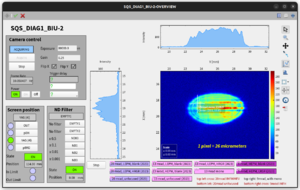
|
| Attachment 2: Screenshot_from_2024-03-15_18-04-39.png
|
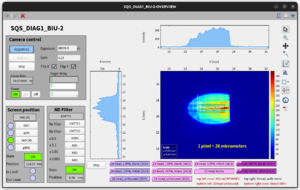
|
|
52
|
15 Mar 2024, 07:08 |
Romain Letrun | SPB | Issue |
There are now two watchdogs for the XTD2 attenuator running at the same time
- SA1_XTD2_WATCHDOG/MDL/ATT1_MONITOR020
- SA1_XTD2_OPTICS_PROTECTION/MDL/ATT1
that are configured differently, which results in different pulse limits (see attachment). |
| Attachment 1: Screenshot_from_2024-03-15_07-07-40.png
|
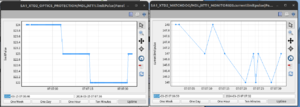
|
|
51
|
15 Mar 2024, 00:16 |
Chan Kim | SPB | Shift summary |
X-ray delivery
6 keV, 2.4 mJ/pulse, stable delivery
Optical laser delivery
800nm PP laser, stable delivery
Achievements/Observations
NKB focus cslits optimized
Some progress with AGIPD background although we still need to improve
Catcher and injector motors (X, Z) are aligned well; with defroster, had under 5mm offset in X
Managed to get a jet and overlap with X-rays.
Issues
Beckhoff flowmeters were disconnected and we were not sure which ports to connect, maybe spent 45min to connect to the right ports and restart device.
Helium flow meter was on but not updating, had to restart it too.
Marco noted actual measured flow at beckhoff VS HPLC set flow was perhaps too low, not sure
Vacuum with injector improved, issue was related to nozzle preparation, however even after this fix the chamber pressure was just over the AGIPD interlock. After tuning gas/liquid flow managed to go under it, but possibly this can also be improved.
Often number of pulses was being changed without us requesting it.
One AGIPD module stopped working after moving quadrant.
DAQ data aggregator crashed a few times, Steffan Hauf will look into this issue after we finished the shift.
Could not move one of the AGIPD quadrant (Q4) due to interlock
Background in Q1 and Q3 needs to be optimized, and/or quadrants needs to be moved.
|
|
50
|
15 Mar 2024, 00:07 |
Harald Sinn | PRC | Issue |
SASE1 bunch number was reduced to 10 pulses for no obvious reason.
Traced it back to a malfunctioning of the watchdog for the solid attenuator (see attached error message)
Deacttivated the watchdog for SASE1 solid attenuator. Re-activated it again.
Issue: SASE1 (SPB?) was requesting 200 pulses at 6 keV with full power with all solid attenuators in the beam. This was a potentailly dangerous situation for the solid attnenuator (!)
After that the team left to go home. Nobody is available at FXE. Set pulse number to 1.
Checked status of solid attenuator. Seems that plate 1&2 have some vertical cracks (see attached picture)
|
| Attachment 1: watchdog_error.jpg
|
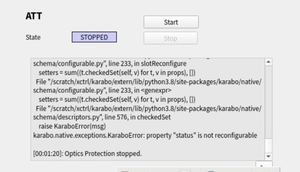
|
| Attachment 2: cracks_in_SA.jpg
|
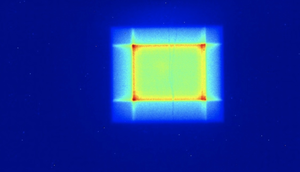
|
|
49
|
13 Mar 2024, 23:41 |
Chan Kim | SPB | Shift summary |
X-ray delivery
- 6 keV, 2.6 mJ/pulse, stable delivery
Optical laser delivery
- 800nm PP laser, stable delivery
Achievements/Observations
- NKB focus optimized and PSLITS optimized
- Beam going through IBS camera
- PP laser rough timing checked w.r.t. X-ray
- Catcher and injector motors (X, Z) are aligned well with about 1.5mm offset in X
Issues
- Manifold-MDL issue (reported in Issues tap)
- SPB_IRU_LIQUIDJET/CAM/1 (IRU nozzle insertion camera) is not working. Power cycle required.
- SPB_EHU_Valve closed 2-3 times due to vacuum interlock
- Space (KF50 pipes) in the super-structure was too long for the user injector (nozzle rod). After taking off small spacer, nozzle is very close to the injector valve during insertion. Please check it out whether we can find any better solution or not.
|
|
48
|
13 Mar 2024, 10:09 |
Romain Letrun | SPB | Status |
We checked the XTD2 attenuators following the intervention from XRO (compar ewith elog:37, before the intervention).
The wavefront shows similar distortions with the 75 and 150 um as earlier, which is not too surprising since the cracks are vertical.
Attachments 1-5: Beam on SPB_XTD9_SCR with XTD2 attenuator CVDs
Attachments 6-7: Beam on FEL imager with XTD2 75 and 150 um CVDs |
| Attachment 1: CVD_75um_2024-03-13_09-48-27.png
|
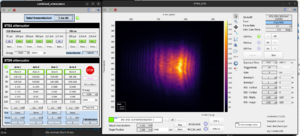
|
| Attachment 2: CVD_150um_2024-03-13_09-49-48.png
|
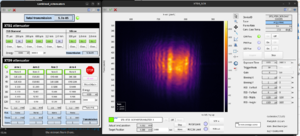
|
| Attachment 3: CVD_300um_2024-03-13_09-50-08.png
|
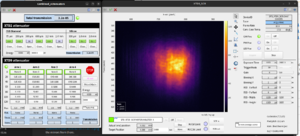
|
| Attachment 4: CVD_600um_2024-03-13_09-50-33.png
|
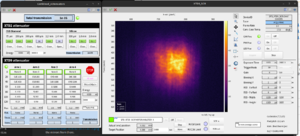
|
| Attachment 5: CVD_1200um_2024-03-13_09-51-41.png
|
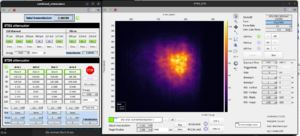
|
| Attachment 6: CVD_75um_2024-03-13_08-06-53.png
|

|
| Attachment 7: CVD_150um_2024-03-13_08-06-07.png
|
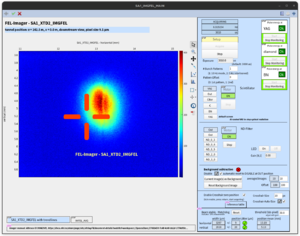
|
|
47
|
05 Mar 2024, 07:41 |
Marcin Sikorski | SPB | Shift summary |
- 10 keV beam
- Detector: JUNGFRAU in the burst mode (16 memory cells)
- Achievements:
- multiple sfx data sets (lysozyme) with 4 and 8 pulses (at 1.1MHz) per exposure taken
|
|
46
|
04 Mar 2024, 09:42 |
Romain Letrun | SPB | Issue |
The number of bunches during the last night shift kept being changed down to 24 by the device SA1_XTD2_WATCHDOG/MDL/ATT1_MONITOR020 acting on SA1_XTD2_BUNCHPATTERN/MDL/CONFIGURATOR. This was not the case during the previous shifts, even though the pulse energy was comparable. Looking at the history of SA1_XTD2_WATCHDOG/MDL/ATT1_MONITOR020, it looks like this device was started at 16:26:25 on Friday, 1st March. |
| Attachment 1: xtd2_att_watchdog.png
|
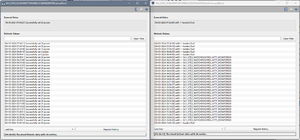
|
|
45
|
04 Mar 2024, 06:52 |
Raphael de Wijn | SPB | Shift summary |
X-ray delivery
- 10 keV, up to 128 pulses with custom bunch pattern, 1.6-2.0 mJ
Optical laser delivery
Achievements/Observations
- collected SFX data with 8 pulses per memory cell with our Jungfrau 4M. Data processing needed to evaluate quality.
Issues
- AGIPD having frequent probles with MFPGA's (both and once even both at the same time). Frequent restarts were needed.
- Jf4M chiller had hard time to reach/keep the setpoint
- downstream CRL arm #9 removed (produced trippel beam on EHD)
- difficulties to minimize bgdd
|